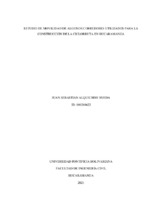Estudio de movilidad de algunos corredores utilizados para la construcción de la ciclorruta en Bucaramanga

Fecha
2021Director/Asesor
Medina Delgado, Gabriel Alexis
Tipo de contenido
Trabajo de grado
Citación
Metadatos
Mostrar el registro completo del ítemDocumentos PDF
Resumen
La excesiva circulación de vehículos colapsa en las ciudades como consecuencia del crecimiento en masa de los automotores, la falta de vías e infraestructura, ya que los diferentes medios de transporte motorizado generan graves problemas de congestión por el alto flujo vehicular. Es por esto, que las bicicletas son una buena alternativa de medio de transporte no motorizado. Por lo tanto, la alcaldía de Bucaramanga ha venido promoviendo el uso de la bicicleta, construyendo tramos de ciclorruta y acondicionando las vías para su uso. De manera que, la presente investigación tiene como estudio el proyecto "Ciclo-Infraestructura" en la ciudad de Bucaramanga, orientado bajo la metodología mixta, con un tipo de investigación de campo e investigación descriptiva, que posteriormente se simulan en el software Synchro. De este modo, al evaluar el flujo vehicular de los corredores de estudio se determina el nivel de servicio, antes y después de la construcción de Ciclorruta, donde se obtiene que la implementación de la Ciclorruta bajó notablemente su nivel de servicio en los corredores con accesos a la avenida Samanes, carrera 21 con calle 39 y finalmente la calle 33. Aún más, se determina que en particular la carrera 21 y la calle 33, consecuentemente ha sido mayor la afectación a comparación con los resultados de la simulación del software, donde es notable la congestión y caos vehicular en la zona a partir de las salidas de campo, ya que se infiere que al ser una zona céntrica donde se detienen una gran cantidad de vehículos automotores para dejar pasajeros y estacionarse, conlleva eventualmente a que se obstruya un carril en circulación y, por ende, se vea aún más afectado el nivel de servicio con el flujo de los vehículos. Excessive vehicle circulation collapses in cities as a result of the mass growth of automobiles, the lack of roads and infrastructure, since the different means of motorized transport generate serious congestion problems due to the high traffic flow. This is why bicycles are a good alternative to non-motorized means of transport. Therefore, the Bucaramanga mayor's office has been promoting the use of bicycles, building sections of cycle paths and preparing the roads for their use. So, the present research is studying the \"Cycle-Infrastructurel" project in the city of Bucaramanga, oriented under the mixed methodology, with a type of field research and descriptive research, which are later simulated in the Synchro software. In this way, when evaluating the vehicular flow of the study corridors, the level of service is determined, before and after the construction of the cycle route, where it is obtained that the implementation of the cycle route significantly lowered its level of service in the corridors with accesses. to Avenida Samanes, Carrera 21 with Calle 39 and finally Calle 33. Furthermore, it is determined that in particular Carrera 21 and Calle 33, consequently the impact has been greater compared to the results of the software simulation, where The congestion and vehicular chaos in the area from the field exits is notable, since it is inferred that being a central area where a large number of motor vehicles stop to leave passengers and park, eventually leads to the obstruction of a lane in circulation and, therefore, the level of service is further affected by the flow of vehicles.
Palabra/s clave
Ciclorruta
Flujo vehicular
Movilidad
Nivel de servicio
Synchro
Colecciones
- Trabajos de grado [6698]
El ítem tiene asociados los siguientes ficheros de licencia:

